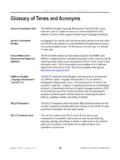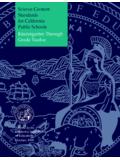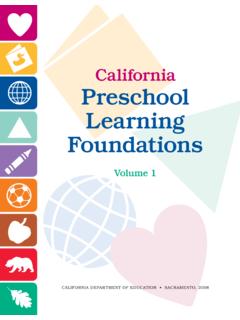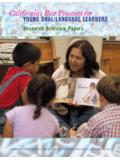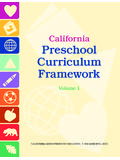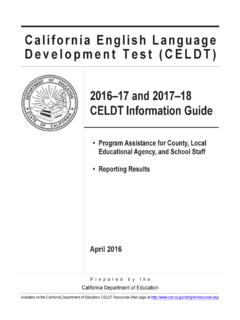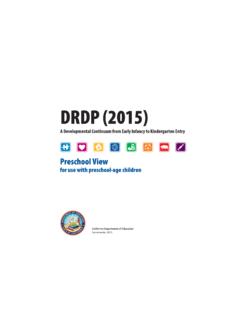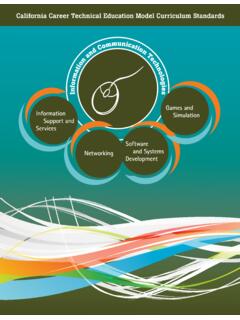Transcription of Physical Education Framework for California Public Schools
1 Physical Education Framework for California Public Schools kindergarten Through grade Twelve Adopted by the California State Board of Education Published by the California Department of Education Sacramento, 2009. Physical Education Framework for California Public Schools kindergarten Through grade Twelve Developed by the Curriculum Development and Supplemental Materials Commission Adopted by the California State Board of Education Published by the California Department of Education Publishing Information When the Physical Education Framework for California Public Schools was adopted by the California State Board of Education on September 11, 2008, the members of the State Board were Ted Mitchell, President; Ruth Bloom, Vice President; James Aschwanden; Alan Bersin; Yvonne Chan; Don Fisher; Gregory Jones; David Lopez;. Kenneth Noonan; and Johnathan Williams. The California State Board of Education approved edits to the Physical Education Framework for California Public Schools on May 6, 2009.
2 The members of the State Board on that date were Ted Mitchell, President; Ruth Bloom, Vice President;. Sophia Angelis; James Aschwanden; Rae Belisle; Yvonne Chan; Gregory Jones;. David Lopez; Jorge Lopez; and Johnathan Williams. This publication was edited by Faye Ong, working in cooperation with Deborah Franklin, Education Programs Consultant, Curriculum Frameworks and Instruc . tional Resources Division. It was designed and prepared for printing by the staff of CDE Press, with the cover and interior design created and prepared by Cheryl McDonald. Typesetting was done by Jeannette Reyes. It was published by the Department of Education , 1430 N Street, Sacramento, CA 95814-5901. It was distributed under the provisions of the Library Distribution Act and Government Code Section 11096. 2009 by the California Department of Education All rights reserved ISBN 978-0-8011-1696-4. Ordering Information Copies of this publication are available for sale from the California Department of Education .
3 For prices and ordering information, please visit the Department Web site at or call the CDE Press Sales Office at 1-800-995-4099. An illustrated Educational Resources Catalog describing publica . tions, videos, and other instructional media available from the Department can be obtained without charge by writing to the CDE Press Sales Office, California Department of Education , 1430 N Street, Suite 3207, Sacramento, CA 95814 . 5901; faxing to 916-323-0823; or calling the CDE Press Sales Office at the telephone number listed above. Notice The guidance Physical Education Framework for California Public Schools is not binding on local educational agencies or other entities. Except for the statutes, regu . lations, and court decisions that are referenced herein, the document is exemplary, and compliance with it is not mandatory. (See Education Code Section ). iii Contents v Introduction .. x Chapter 1. Vision and Goals for Standards-Based Physical Education ..1. Chapter 2. Standards-Based Physical Education : kindergarten Through grade kindergarten .
4 15. grade One ..25. grade Two ..36. grade Three ..47. grade Four ..58. grade Chapter 3. Standards-Based Physical Education : Grades Six Through Eight ..82. grade Six ..85. grade Seven ..96. grade Eight ..104. Chapter 4. Standards-Based Physical Education : Grades Nine Through High School Course 1 ..117. High School Course 2 ..125. High School Course 3 ..134. High School Course 4 ..148. Chapter 5. Assessment ..157. Types of Assessment ..158. Principles of Assessment ..160. Assessment Tools ..161. Assessing the Skills and Concepts Learned ..171. State-Required Physical Performance Test ..184. Assessment and the Use of Technology ..185. Grading Practices in Standards-Based Physical Education ..188. Chapter 6. Instruction ..190. Instructional Models ..192. Establishing a Safe Environment ..193. Class Management ..195. Effective Teaching Behaviors ..196. Principles of Motor Learning ..197. A Sample Physical Education Lesson ..199. Instructional Strategies ..201. Multidisciplinary iv Chapter 7.
5 Universal Access ..206. Establishing an Inclusive Environment ..207. Students Who Are Accommodating Cultural and Religious Practices ..212. English Learners ..214. At-Risk Students with Medical Conditions ..217. Advanced Learners ..217. Students with Disabilities (IEPs and Section 504 Plans) ..218. Chapter 8. Supporting High-Quality Physical Education ..225. Administrative Role and Support ..226. Teacher Leaders ..235. College and University Community and Parent Support ..236. Chapter 9. Instructional Evaluation Process ..239. Evaluation of Instructional Evaluation of Equipment and Supplies ..243. Evaluation of Technology ..244. Facilities ..252. Appendixes A: Selected Laws and B: Content Areas of Standards, by grade Level ..281. C: The Movement Framework in Games, Gymnastics, and Dance ..284. D: Concepts and Principles of Biomechanics ..286. E: Concepts and Principles of Motor F: Contraindicated and Alternative Exercises ..292. G: Standards-Based Report Card, Example #1.
6 297. H: Standards-Based Report Card, Example #2 ..298. I: Adapted Physical Education Pre-referral Checklist ..301. J: Quality Indicators: Physical Education Standards-Based K: Careers in Physical Education ..304. L: Online Resources ..306. M: Guidelines for Facilities ..309. Glossary ..312. Works Additional References ..329. v Foreword W. ith the adoption of the Physical Education Model Content Standards for California Schools in January 2005, California raised the bar for Physical Education instruction. High-quality, standards-based Physical Education instruction helps students learn not only the skills and knowledge to be physically fit and active, it also gives them the confidence and positive attitude necessary to participate in Physical activities. The Superintendent's Task Force on Childhood Obesity, Type 2 Diabetes, and Cardiovascular Disease recommends increasing the quality and quantity of instruction in Physical Education to provide more Physical activity and enhance student achievement of California 's Physical Education Model Content Standards.
7 Including Physical Education as core curriculum; and treating Physical activity as essential to all students' Education and health. The Physical Education Framework for California Public Schools : kindergarten Through grade Twelve, adopted by the State Board of Education on September 11, 2008, is an essential resource for the development, implementation, and evaluation of standards-based Physical Education programs and instruction to meet the recommendations of the task force. Its adoption reinforces the importance of Physical Education as a vital component of our students' educa . tional experience and its contribution to each student's health and well-being, social development, and readiness to learn. The Framework charges administrators and teachers with instituting standards- based Physical Education instruction and programs that are effective for every student. Focused on the model content standards and supported by current research, the Framework emphasizes student learning with the goal of helping every student adopt a physically active lifestyle.
8 Developed and reviewed by teachers, administrators, and Physical Education experts, the Framework features practical examples and scenarios of student learning to assist teachers in planning instruction. The Framework describes the why, when, and how of assessing student learning and presents detailed examples of different types of assessment. It provides guidance on creating a physically and emotionally safe learning environment. Based on the premise that every student can be successful in Physical Education with good instruction and appropriate resources, the Framework also offers suggestions for adaptations to meet the instructional needs of students with disabilities or other challenges to learning. Recognizing that effective standards-based Physical Education programs require administrative leadership and support, the Framework addresses topics of interest to school-site and district-level administrators, including professional development, curriculum design, instructional and program evaluation, and the selection and maintenance of high-quality instructional resources.
9 Vi Most important at a time when more children than ever before are obese and inactive, the Framework is a call to action. It maps out a path to a physically active, healthy lifestyle for all students. Open the Framework and we'll start down the path together. Jack O'Connell Theodore R. Mitchell State Superintendent of Public President, State Board Instruction of Education vii Acknowledgments T. he 2009 edition of the Physical Education Framework for California Public Schools was adopted by the State Board of Education on September 11, 2008. When the Framework was adopted, the following persons were serving on the State Board: Ted Mitchell, President Ruth Bloom, Vice President James Aschwanden Alan Bersin Yvonne Chan Don Fisher Gregory Jones David Lopez Kenneth Noonan Johnathan Williams Members of the Curriculum Development and Supplemental Resources Commission serving in May 2008, when the Framework was recommended for adoption by the State Board, were: Katherine Crawford, Chair, Alameda Unified School District Constance (Connie) Tate, Vice Chair, San Joaquin County Office of Education Hope Bjerke, Tehama County Office of Education John Brooks, Oceanside Unified School District Linda Childress, Riverside County Office of Education Patricia Dixon, Palomar College Martha Hernandez, Ventura County Office of E.
10 Education ducation Glee Johnson Christine Lanphere, Natomas Unified School District Lucy Medina, Palm Springs Unified School District Bama Medley, Santa Maria-Bonita Elementary School District Assembly Member Gene Mullin, Assembly Education Committee Dr. RoseMary Parga-Duran, Merced City Elementary School District Senator Jack Scott Becky Sullivan, Sacramento County Office of Education Richard Wagoner, Los Angeles Unified School District Monica Ward, Riverside Unified School District Kevin Wooldridge, Education for Change Charter Management Organization Note: Names and affiliations of individuals were current as of the time this publication was developed. viii Participating directly in the development and approval process for the frame . work were the following members of the Physical Education Subject Matter Committee from 2005 through 2008: Katherine Crawford (Member 2005, 2007). Patricia Dixon (Member 2005, 2006, 2007, 2008). Martha Hernandez (Member 2008). Mary-Alicia McRae (Vice Chair 2005).

